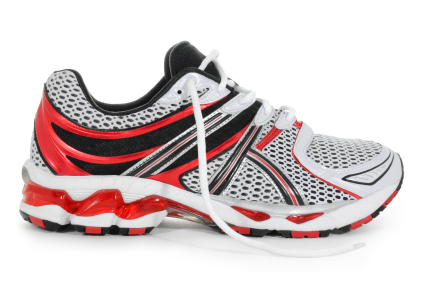How To Tie a Shoe
Most experienced runners have a preferred brand of running shoe. Mizuno, Asics, New Balance and Saucony seem to be common choices among our patients, but the jury is still out as to which manufacturer truly makes the best shoe. Since there are no objective, scientific guidelines to direct your purchase, it seems to boil down to personal preference. Thanks to some recently published research, lacing up your chosen shoe is a different story…
Best Lacing Pattern for Runners
This past February, an interesting paper was published in the Journal of Sports Sciences which investigated the various lacing patterns in running shoes. Using force plates, pressure transducers and accelerometers attached to the leg, the authors measured how different lacing patterns would influence pronation of the foot, tibial acceleration and pressure distribution in the bottom of the foot. The authors laced the shoes using one, two, three, six or seven eyelets in addition to investigating the tightness of the laces (weak, regular or strong). The interesting results were as follows…
Pronation Control, Pressure at Impact…
When shoes were laced tighter, using all the eyelets, there was a lower rate of loading and the foot pronated slower (which is a good thing). This lacing pattern also showed the lowest peak pressure under the heel and the outside of the foot.
When a six-eyelet / cross lacing pattern was used, a higher loading rate and higher peak heel pressure was observed when compared to the seven eyelet method. Interestingly, the participants did not report a difference in perceived comfort between these two lacing patterns.
Reduced impact and lower peak pressures were observed under the third and fifth toes when only the lower eyelets of the shoes were used. This interesting finding was explained by the foot sliding within the shoe during the stance phase.
So How Should We Tie Our Shoes?
Therefore, the findings of this interesting study suggest that using each of the eyelets in a running shoe (and lacing them up firmly) allows your foot to experience the full benefit of what the shoe was designed for. Under most circumstances, good running shoes are designed to reduce impact and control excessive rear foot pronation. Lace them up properly and they might actually achieve that!
Our Physiotherapy and Chiropractic clinic in Burlington treats running related injuries on a daily basis. Our patients range from beginner runners to experts…everyone is welcome! For more information about our services please don’t hesitate to contact us. If you are a runner, you may want to check out our active release technique page or our graston page…these techniques seem to be VERY popular with our running patients! 905.220.7858. info@burlingtonsportstherapy.com
References
Hagen M, Hennig EM. Effects of different shoe-lacing patterns on the biomechanics of running shoes. Journal of Sports Sciences 2009; 27(3):267-275.
Disclaimer
The purpose of this blog is to educate our patients and those interested in improving their health and wellbeing. We recommend that you always consult with a qualified health care professional before applying any of the topics or suggestions mentioned on this website. This information is not intended to diagnose or treat your condition. Burlington Sports Therapy, Dr. McIntyre or Dr. McDowall accept no responsibility for any complications arising from the use of any suggestions, exercises or topics of discussion on this site.









